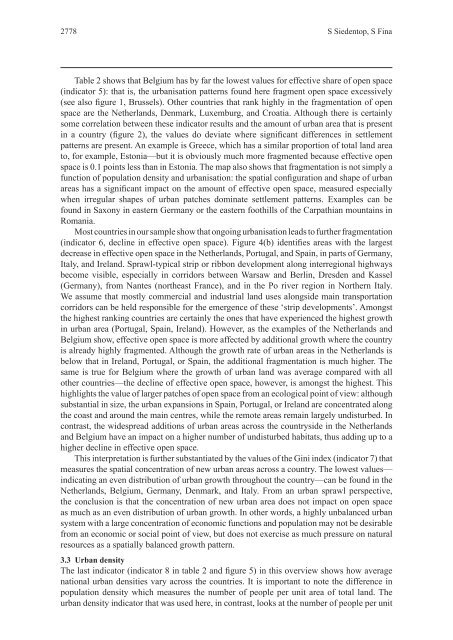PDF 20.134kB - TOBIAS-lib - Universität Tübingen
PDF 20.134kB - TOBIAS-lib - Universität Tübingen
PDF 20.134kB - TOBIAS-lib - Universität Tübingen
Sie wollen auch ein ePaper? Erhöhen Sie die Reichweite Ihrer Titel.
YUMPU macht aus Druck-PDFs automatisch weboptimierte ePaper, die Google liebt.
2778 S Siedentop, S Fina<br />
Table 2 shows that Belgium has by far the lowest values for effective share of open space<br />
(indicator 5): that is, the urbanisation patterns found here fragment open space excessively<br />
(see also gure 1, Brussels). Other countries that rank highly in the fragmentation of open<br />
space are the Netherlands, Denmark, Luxemburg, and Croatia. Although there is certainly<br />
some correlation between these indicator results and the amount of urban area that is present<br />
in a country ( gure 2), the values do deviate where signi cant differences in settlement<br />
patterns are present. An example is Greece, which has a similar proportion of total land area<br />
to, for example, Estonia—but it is obviously much more fragmented because effective open<br />
space is 0.1 points less than in Estonia. The map also shows that fragmentation is not simply a<br />
function of population density and urbanisation: the spatial con guration and shape of urban<br />
areas has a signi cant impact on the amount of effective open space, measured especially<br />
when irregular shapes of urban patches dominate settlement patterns. Examples can be<br />
found in Saxony in eastern Germany or the eastern foothills of the Carpathian mountains in<br />
Romania.<br />
Most countries in our sample show that ongoing urbanisation leads to further fragmentation<br />
(indicator 6, decline in effective open space). Figure 4(b) identi es areas with the largest<br />
decrease in effective open space in the Netherlands, Portugal, and Spain, in parts of Germany,<br />
Italy, and Ireland. Sprawl-typical strip or ribbon development along interregional highways<br />
become visible, especially in corridors between Warsaw and Berlin, Dresden and Kassel<br />
(Germany), from Nantes (northeast France), and in the Po river region in Northern Italy.<br />
We assume that mostly commercial and industrial land uses alongside main transportation<br />
corridors can be held responsible for the emergence of these ‘strip developments’. Amongst<br />
the highest ranking countries are certainly the ones that have experienced the highest growth<br />
in urban area (Portugal, Spain, Ireland). However, as the examples of the Netherlands and<br />
Belgium show, effective open space is more affected by additional growth where the country<br />
is already highly fragmented. Although the growth rate of urban areas in the Netherlands is<br />
below that in Ireland, Portugal, or Spain, the additional fragmentation is much higher. The<br />
same is true for Belgium where the growth of urban land was average compared with all<br />
other countries—the decline of effective open space, however, is amongst the highest. This<br />
highlights the value of larger patches of open space from an ecological point of view: although<br />
substantial in size, the urban expansions in Spain, Portugal, or Ireland are concentrated along<br />
the coast and around the main centres, while the remote areas remain largely undisturbed. In<br />
contrast, the widespread additions of urban areas across the countryside in the Netherlands<br />
and Belgium have an impact on a higher number of undisturbed habitats, thus adding up to a<br />
higher decline in effective open space.<br />
This interpretation is further substantiated by the values of the Gini index (indicator 7) that<br />
measures the spatial concentration of new urban areas across a country. The lowest values—<br />
indicating an even distribution of urban growth throughout the country—can be found in the<br />
Netherlands, Belgium, Germany, Denmark, and Italy. From an urban sprawl perspective,<br />
the conclusion is that the concentration of new urban area does not impact on open space<br />
as much as an even distribution of urban growth. In other words, a highly unbalanced urban<br />
system with a large concentration of economic functions and population may not be desirable<br />
from an economic or social point of view, but does not exercise as much pressure on natural<br />
resources as a spatially balanced growth pattern.<br />
3.3 Urban density<br />
The last indicator (indicator 8 in table 2 and gure 5) in this overview shows how average<br />
national urban densities vary across the countries. It is important to note the difference in<br />
population density which measures the number of people per unit area of total land. The<br />
urban density indicator that was used here, in contrast, looks at the number of people per unit

















